On the Waterfront Locations
On the Waterfront: A Classic Film Created in Hoboken

The 1954 film On the Waterfront was shaped by its setting in Hoboken. On the Waterfront featured Marlon Brando as Terry Malloy, a tough guy struggling with his conscience and his loyalty to a waterfront gang. While most movies at the time were filmed on studio stages, On the Waterfront was filmed on location, mostly in Hoboken. Many Hoboken residents played extras or even minor characters.
The Hoboken Historical Museum has compiled a map of film locations in town. Click here to view the map.
On the Waterfront won numerous Academy Awards including best picture, best director (Elia Kazan), best story and screenplay (Budd Schulberg), best actor (Marlon Brando), and best supporting actress (Eva Marie Saint). It also won awards for best black and white cinematography (Boris Kaufman) and best black and white art direction and set direction (Richard Day).
Hoboken was an ideal setting for a bold display of gritty realism. Barely recognizable from today’s waterfront with its upscale buildings and picturesque parks, Hoboken’s waterfront in the 1950s was a working port where longshoremen would daily “shape-up” to be selected for jobs by a mob-connected hiring boss. The sounds and backgrounds captured by the filmmakers helped immerse the viewer in the story in a way that would have been difficult to create on an isolated sound stage.
Many of Hoboken’s past and current landmarks are seen in the film, but at least one important scene was not shot in Hoboken. The filmmakers had a hard time getting inside a ship in Hoboken’s busy port, so the scene inside a ship’s hold were filmed at Red Hook in Brooklyn. Sources differ on whether the car in which Terry tells Charley that he “could have been a contender” was parked in Hoboken or in a studio outside of town. Either way, Marlon Brando exits the car on Hoboken’s River Street.
Many Hoboken residents left their imprint on the film. Most were non-speaking extras who silently added their presence to various scenes. Others had more recognizable or unique roles.
During the first shape-up in the film, Hoboken longshoreman Marty Russo cries out “Who do you have to see to get a day’s pay around here?” Russo, who said he was expressing actual frustration with the hiring system, went onto minor roles in other films. Police officers in the film were real members of the Hoboken Police department. Officer Pete King restrained Johnny Friendly in the courtroom, and later told a resentful Malloy that he “oughta be glad we’re following you.” Frank Marnell, a gym teacher at Rue School, played the nameless overlord who turned off the television during Johnny Friendly’s testimony. He reappeared in the end of the film to say “All right. Let’s go to work.”
 Tommy Hanley was thirteen years old when he noticed a crew working on the roof at his apartment building at 105 Hudson Street. When he went to investigate, he found men setting up a pigeon coop for a movie they were making. The carpenter, a local man, hired Tommy to feed the pigeons.
Tommy Hanley was thirteen years old when he noticed a crew working on the roof at his apartment building at 105 Hudson Street. When he went to investigate, he found men setting up a pigeon coop for a movie they were making. The carpenter, a local man, hired Tommy to feed the pigeons.
Tom Hanley long believed that his father had been murdered by waterfront gangsters. Longshoreman Arthur “Brownie” Brown had much respect for Hanley’s father and wanted to get Tommy into the movie. He set up a meeting with Kazan and Schulberg, who cast Hanley as Tommy, a young friend of Terry who looks over the pigeon coop. Hanley recalled in a interview that Brando was easy to work with, nice to him and his mother, and took the train to the set wearing his costume.
Hanley said that people commended him for his role in the movie, but that he did not like it because his character wasn’t tough enough for his liking. Hanley later became a longshoreman, a job he held until 2009.
Other Hobokenites left their marks. The jacket that passed from Joey Dugan to Terry Malloy actually belonged to a Hoboken longshoreman named Johnny Sanducci. Jimmy Francis, a longshoreman and ex-boxer, watched director Elia Kazan make Brando do multiple takes of a scene where his character walks away from a severe beating. Francis, who was no stranger to getting punched, demonstrated how he would walk after a tough match. Kazan then had Brando follow Jimmy Francis’s example.
Hoboken longshoreman Anthony “Tony Mike” DiVincenzo had a big influence on the film. Writer Budd Schulberg had spent a lot of time in Hoboken,hanging out in waterfront bars and following developments in crime stories. A major witness against corrupt union bosses emerged. Tony Mike boldly and plainly spoke of the corruption and violence within the union, and received threats against his life that were never successfully carried out.
People who worked on the movie largely recall Hoboken as a welcoming place to work. Many residents were enthusiastic about the project. Gangs were less powerful on Hoboken’s shores than they were on the docks across the Hudson, and film crews were well protected.
On the Waterfront is a beautifully produced snapshot of Hoboken heritage featuring many of the mile square city’s attractive locations and honest people. Hoboken was the setting for an inspiring story of redemption and people coming together to defeat corruption and intimidation.
Sources:
DVD: On the Waterfront, The Criterion Collection, 2013.
Supplement: Criterion Collection interview with Thomas Hanley, 2012
Supplement: Richard Schickel interview with Elia Kazan, 2001.
“Hoboken’s Waterfront,” an essay by Sada Fretz. From the book On the Waterfront: Starring Hoboken, New Jersey. Hoboken Historical Museum, 2004.
On The Waterfront at Imdb.com.
“On the Waterfront,” Hoboken History, Number 18, 1997.
Oscar Legacy: The 27th Academy Awards (1955) Nominees and Winners. Oscars.org.
This digital exhibit was created by Darian Worden for the Hoboken Historical Museum, 2014.
Thank you for visiting our page. Come visit us at 1301 Hudson Street for changing exhibits about Hoboken’s rich and varied history.








